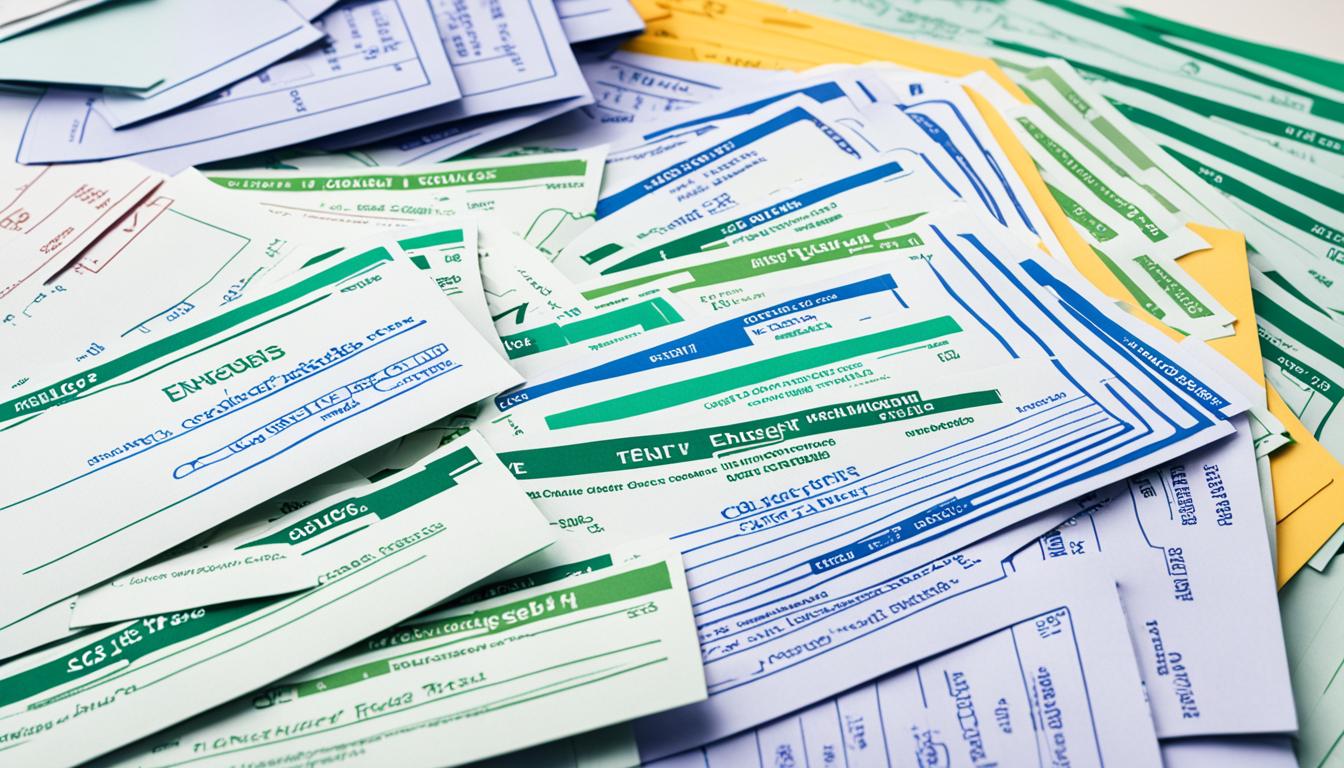As I looked over my bank statements, a familiar feeling of worry came up. The numbers didn’t match, and I felt like I was always short on cash. Have you ever felt this way? If so, you’re not alone. But, what if I told you that budgeting could change everything?
This guide will show you how to budget and manage your money well. It doesn’t matter if you’re new to personal finance or if you’re already good at saving. We’ll give you the tools and strategies to take charge of your money and live freely.
Key Takeaways
- Discover the importance of budgeting for financial success
- Learn how to effectively track your income and expenses
- Create a realistic budget plan that balances your needs and wants
- Uncover strategies for cutting costs and finding savings
- Explore debt reduction methods and the power of an emergency fund
- Understand investment options for long-term financial growth
- Achieve your specific financial goals, from retirement to education
Understanding the Importance of Budgeting
Budgeting is key to financial success. It’s the base for individuals and families to secure their financial future. By grasping the importance of budgeting, you can manage your money better and reach your financial goals.
Why Budgeting Matters for Financial Success
Budgeting is crucial for several reasons:
- Expense Control – A good budget lets you track spending, find ways to spend less, and make sure your money matches your priorities.
- Debt Reduction – Budgeting helps you set aside money for debt payments. This reduces your debt and boosts your financial health.
- Goal Achievement – With a budget, you can put money towards specific goals, like saving for a house or an emergency fund.
Goals and Priorities: Setting the Foundation
Before making a budget, define your financial goals and priorities. Think about these questions:
- What are my short-term and long-term financial goals?
- What’s the most important thing I want to do with my money?
- How can I make sure my spending matches my values and priorities?
Answering these questions helps you build a strong base for budgeting. This ensures your money management fits your unique needs and dreams.
“A budget is telling your money where to go instead of wondering where it went.” – Dave Ramsey
Budgeting and financial planning go together. Knowing the value of budgeting and setting clear financial goals helps you manage your money better. This leads to long-term financial success.
| Financial Goal | Budgeting Benefit |
|---|---|
| Reducing Debt | Budgeting lets you put money directly towards debt payments, helping you pay off balances faster. |
| Building an Emergency Fund | A budget can show you where to cut expenses and use that money for savings. |
| Saving for Retirement | Budgeting helps you set aside income for retirement savings, making sure you’re ready for the future. |
Tracking Your Income and Expenses
Understanding your finances starts with tracking your income and expenses. This step is key to managing your money well. By keeping an eye on what comes in and goes out, you learn how you spend and find ways to save.
There are many tools and methods to track your money. You can use simple spreadsheets or powerful apps, depending on what you like and need. The main goal is to keep a detailed record of your spending, sort it out, and understand your habits.
Importance of Expense Tracking
Keeping track of your spending is vital for managing your money well. Knowing where your cash goes helps you decide where to spend less, save more, and meet your financial goals.
By tracking your spending, you can:
- Spot spending you don’t need
- Use your money better
- Find and fix money leaks
- Understand your finances better
- Make smarter choices about saving and budgeting
Tools and Methods for Tracking Expenses
You have many ways to track your money. Pick what works best for you and fits your life. Here are some options:
- Spreadsheets: Use tools like Microsoft Excel or Google Sheets to track your spending by hand.
- Personal Finance Apps: Apps like Mint, YNAB, or Personal Capital track your spending automatically and help with budgeting.
- Online Banking and Statements: Banks often have tools to see your spending history and categorize it for you.
- Receipts and Invoices: Keep your receipts and invoices to track your spending the old-school way.
It doesn’t matter how you track your money, the important thing is to do it regularly. Keep your spending accurate and check your finances often. This helps you make smart choices about saving and managing your money, leading to better financial health.
Creating a Realistic Budget Plan
Making a practical budget is key to financial success. It’s about sorting your expenses and balancing needs with wants. This way, you can make a budget that fits your financial situation and helps you save.
Categorizing Expenses: Fixed vs. Variable
Start by sorting your expenses into fixed and variable groups. Fixed expenses stay the same every month, like rent or car payments. Variable expenses change based on how you spend and live, like groceries or going out.
Balancing Needs and Wants
Once you know your fixed and variable costs, it’s time to decide what to spend on. Put your spending into “needs” and “wants” to use your money wisely. Needs are must-haves like a home, bills, and health care. Wants are things you choose to spend on, like eating out or trips.
By balancing your spending, you can pay for what you need and still have fun. It’s about making smart choices on where to spend and cutting back on the extras.
A realistic budget isn’t about cutting back too much. It’s about finding a balance between living now and planning for the future. With a good budget, you can manage your money better and build a strong financial base for the long run.
Cutting Costs and Finding Savings
Getting financially stable and growing your wealth starts with cutting unnecessary expenses and finding ways to save. Look at your subscriptions and negotiate bills to save money. There are many tips and techniques to help you manage your budget better and increase your savings.
Reducing Unnecessary Expenses
One key way to save more is by cutting unnecessary expenses. Begin by checking your monthly spending and sorting your expenses into fixed and variable categories. This makes it easier to see where you can cut costs.
- Evaluate your subscriptions and memberships: Cancel any services or subscriptions you no longer use or need.
- Negotiate bills and utilities: Contact your providers and ask if they can offer a lower rate or better plan.
- Find affordable alternatives: Look for more budget-friendly options for goods and services, such as generic brands or second-hand purchases.
- Reduce discretionary spending: Limit spending on non-essential items like dining out, entertainment, and impulse purchases.
By reviewing your expenses and using these cost-cutting strategies, you can save a lot of money. You can then use this money for your financial goals, like paying off debt or building an emergency fund.
| Expense Category | Cost-Cutting Strategies |
|---|---|
| Subscriptions and Memberships | Cancel unused services, negotiate discounts, or find free alternatives |
| Utilities | Compare rates, request discounts, or adjust usage habits |
| Grocery and Household Items | Buy in bulk, use coupons, and opt for generic or store-brand products |
| Transportation | Use public transportation, carpool, or explore more affordable vehicle options |
By using these money-saving tips and techniques, you can free up funds for your financial goals. This helps you build a more secure financial future.

Strategies for Paying Off Debt
Paying off debt is key to managing your finances well. Two strategies, the debt snowball and debt avalanche, are popular for reducing debt. Knowing the differences between them can help you pick the best way to reach your financial goals.
Debt Snowball
The debt snowball method starts with the smallest debts, not the ones with the highest interest rates. You put extra money towards the smallest balance first. This way, you quickly clear those debts and feel a sense of progress.
After paying off a debt, you use the same money for the next smallest balance. This creates a “snowball” effect, helping you speed up your debt repayment.
Debt Avalanche
The debt avalanche method targets the debts with the highest interest rates first. This can save you more money over time by cutting down the interest you pay. By focusing on the most expensive debts, you make the most of your payments and move faster towards being debt-free.
Choosing either the debt snowball or debt avalanche method is important. Staying consistent and disciplined with your payments is key. Both strategies can help you reduce your debt and take charge of your finances.
| Debt Snowball | Debt Avalanche |
|---|---|
| Focuses on paying off smallest debts first | Focuses on paying off highest interest rate debts first |
| Provides a psychological boost as you pay off debts | Saves more in interest in the long run |
| Requires less math and planning | Requires more discipline and focus |
The main goal is to find a debt repayment method that fits your financial situation and keeps you motivated. This way, you can stick to your debt reduction plans.
Building an Emergency Fund
Having an emergency fund is key to financial stability. It acts as a safety net for unexpected costs like medical bills or car repairs. By saving for emergencies, you protect your financial well-being and feel more secure.
It’s wise to save three to six months’ worth of expenses in your emergency fund. This amount helps you handle sudden financial challenges without using regular savings or taking on high-interest debt. Start by saving a small part of your monthly income to grow your fund.
Here are some tips to help you save for emergencies:
- Automate your savings by setting up automatic transfers from your checking to a savings account. This “pay yourself first” method makes saving easier.
- Look for ways to increase your savings, like using tax refunds or bonuses for your emergency fund.
- Always try to refill your emergency fund after using it, so it’s always there for unexpected costs.
Building a strong emergency fund not only protects your finances but also builds financial resilience. When unexpected problems come up, you’ll have the money to deal with them without hurting your long-term goals.

| Emergency Fund Recommendation | Savings Goal |
|---|---|
| 3-6 months’ living expenses | Provides a financial cushion to cover unexpected costs without dipping into regular savings or relying on debt |
Investing for Long-Term Financial Growth
Investing is key to growing your money over time. By picking the right investment options, you can reach your financial goals. Whether you want to save for retirement, a house, or just grow your savings, investing can help.
Understanding Investment Options
There are many ways to invest your money. You can choose from stocks, bonds, real estate, mutual funds, and ETFs. Each option has its own level of risk and reward. It’s important to know what you’re getting into.
- Stocks – Investing in companies can lead to big gains but also comes with more risk.
- Bonds – Bonds are stable investments that offer predictable returns but don’t grow as much.
- Mutual Funds and ETFs – These options let you invest in many assets at once, helping to spread out risk through asset allocation.
- Real Estate – Real estate can earn you income and grow in value, but it takes a big upfront investment.
When planning your investments, think about how much risk you can handle, your timeline, and your goals. Diversifying your investments across different types can help you grow your money over time.
“Investing should be more like watching paint dry or watching grass grow. If you want excitement, take $800 and go to Las Vegas.” – Paul Samuelson
Budgeting and Saving Money for Specific Goals
Managing your money well is key to reaching your financial goals. This includes saving for retirement or your child’s education. This section will show you how to set priorities and save effectively.
Saving for Retirement
Planning for retirement is vital for your financial future. Start saving early and put money into retirement accounts like 401(k)s or IRAs. This way, you can use compound interest to grow your savings. Look into mutual funds and index funds to increase your retirement savings.
Saving for Education
Saving for your children’s education is a big step. With good budgeting and saving, you can make sure they have what they need. Think about a 529 college savings plan for tax benefits on growth and withdrawals for school costs. Saving part of your budget for education helps your family and keeps your finances strong.


